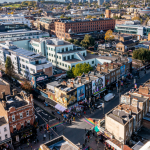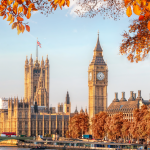Guy Nicholson is not your typical councillor – but then again, there’s nothing “typical” about Hackney, the borough where he’s been an elected councillor for no less than 24 years. Nicholson started his career in the theatre industry and over the years has also been a board member, trustee and advisor to a variety of bodies shaping London’s cultural, economic and built environment – and indeed is, currently, Chair of Newable, the economic development company wholly owned by all 33 London Boroughs. The breadth of this experience matches his briefs as Hackney’s Deputy Mayor for Housing Supply, Planning, Culture and Inclusive Economy.
After all, he says, “one way or another, everything triangulates, everything falls under regeneration”. He stresses that there is no single measure for success, as regeneration is ultimately about the management of “a portfolio of ambitions, activities and projects within a space, all running in parallel and being delivered simultaneously. And hopefully, if you get it right, you end up with them all concluding and converging at the same moment”. That intellectual standpoint, he notes, is also reflected in the borough’s practical approach to planning and regeneration, which seeks to identify the particular needs and leverage the potential of each of Hackney’s “villages”.
“Shoreditch, for example, is profoundly dissimilar from Hackney Wick, which in turn is profoundly dissimilar to the likes of Hackney Central or Dalston. But there is a synergy there, which can be nurtured and taken advantage of”. Hackney has sought to embrace that diversity by tailoring its approach to different parts of the borough, driven by “a programme of area plan-based policies, as that is the only way you can recognise the character, difference and heritage of these places”.
Taking Shoreditch, he describes the area’s rapid evolution as “a number of different iterative regeneration initiatives, culminating more recently with the Tech City ‘brand’”. This has been a primarily “economic development-led initiative”, originally spearheaded by small and micro businesses and more recently attracting the likes of Amazon UK, creating “one of the most successful urban economies in the UK”. All of which, of course, followed the natural decline of the neighbourhood’s “traditional” industries such as furniture-making and fashion design, a period of relative “dereliction” and then a “takeover” by artists and creatives. Back to the present, the challenge for the borough in Shoreditch is in “recognising that change and that evolution, then adapting public policy around that, to enable SMEs and micro-business – the engine of ideas and creativity – to still sit and work alongside the larger corporates”.
Nicholson notes that work on an Area Action Plan for Shoreditch was rightly “paused” because of the pandemic, to allow the council to consider the “recalibration” of its local economy. Indeed, when speaking of the Central Activities Zone – of which Shoreditch comprises the north-eastern edge – Guy does not mince his words. The CAZ “has struggled quite dramatically” as a result of the pandemic. But he points to the “rediscovery” of Hackney’s other town centres by their own local population as “bringing forward a different regeneration dynamic, a different market”.
That’s because places like Hackney Central and Dalston have “gone the other way completely, because people are living in or around the corner from them – and therein lies the future for regeneration, certainly in this neck of London”. “We have to think more intelligently about how we live, work and play in our urban centres – and to recognise that our business models need to adapt to that. We have to think ‘where does my project fit into that place, what contribution does it make?’”. He underlines that that is not just an ethical stance: “the reality is that this is a quantifiable and monetizable proposition, which works to everybody’s advantage. What’s not to like about it?”.
Turning to Hackney Wick and the wider Olympic Park area, he says that here, Hackney has sought to leverage the “longevity and continuity” of its presence as a municipal authority to more actively shape this rapidly changing local area over the past 15 years. “As a council, we were connecting and shaping what that Olympic bid should look like from a Hackney perspective from the very beginning”.. And with London approaching the Games’ 10th anniversary this summer, Guy already sees “an extraordinary legacy” in place.
He does however acknowledge that in Hackney Wick too, collaboration between the private and public sectors has been critical. He highlights Here East, where developer Delancey “embraced a vision, which emanated very much from the public sector, of some kind of centre for creativity, learning, research and development” and which the council “left to colleagues in the market to shape and to deliver”. And “by crikey”, he says “they’ve done that, at speed and at some scale – and all credit to the wider Here East team too, for achieving what they have done to date”. Guy speaks with particular pride of how the Olympic legacy was the “catalyst” to bringing in UCL, the Bartlett, Loughborough University, the London College of Fashion and other higher education institutions, “creating new opportunities and places, for a new generation”.
Nicholson also takes us on a whistle-stop tour of other key areas for the borough beyond the CAZ, from comparatively smaller but regionally significant town centres, to densely built but still-growing residential neighbourhoods like Stamford Hill and of course Woodberry Down. There, the council is working with Berkeley Homes, Notting Hill Genesis and others to build “an entirely new town” of some 5,000 new homes, complete with an entirely new town centre and array of community infrastructure. In each of these areas, Hackney has taken a tailored and ever-evolving approach.
He insists that this adaptability is “one of the great skills of regeneration” and argues that “one has got to try to make sure that policy is not so rigid that it kills the very goose that is laying the golden egg” and that “those that are deploying policy, whether that relates to planning or procurement, should be enabled to be flexible and adapt to the circumstances of the day”. He rejects the stereotype of local government as “staid and stick in the mud” arguing that good councils “are quite exciting and creative places” and “an agent of change, there to support as well as enable”.
Of course, as with all of the senior local government leaders we have spoken to in this series of interviews, Guy stresses that a key ambition and challenge for the borough is “making regeneration of the people and for the people”. He is under no illusions about “the pressure of return on investment, or the need to conclude on a project” and recognises that “trying to shape policy such that local residents and businesses don’t feel that regeneration is being done to them, but rather with them… is not easy”. But when done right, he argues, the results are worth the investment.
Looking to the local elections on 5 May, Guy reveals that he is standing again and “looking forward to another term”, cheerfully adding the caveat that “we’ll have to see, I may get slung out of course!”. He says he is “neither complacent, nor wallowing in the past” and that he is “learning, keeping myself on the front foot, and thinking ahead”. “I’ve always said to myself that the day I get bored, or can’t be bothered, then I’ll know I’ve got to pack it in, step back and let someone else take over – and it hasn’t happened yet.”
His final word for our readers is that “now, more than ever, all of us have got to look at place rather than project”. With communities “rediscovering their local places’ importance” over the past two years, there must be a renewed focus on the quality and variety of those places’ “offer”, with residential, work, community, cultural and green spaces “all happening in the local sphere, in a really interesting urban re-cast”. In many ways, he says, “London’s future lies in going back to its ‘villages’. They are the source of its strength and its resilience, they are the engine and they will lead London back”.
This interview was conducted by London Communications Agency on behalf of the London Property Alliance as part of its curation of the monthly Central London Planning & Politics newsletter.
Read more from our London Leaders series here.


